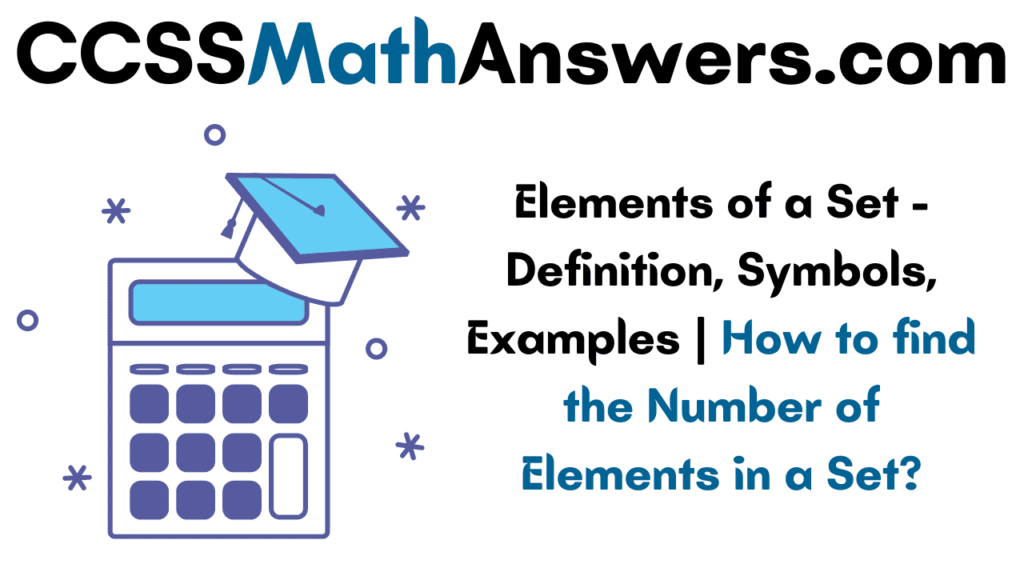Do you want to know what is meant by elements of a set? If yes, then stay tuned to this page. Students can see the example problems on how to find set elements and element definition. You can also check what is the size of a set. Set size and elements are related terms, one depends on the other. Generally, sets are represented using curly braces { }.
What are the Elements of a Set?
Elements of a set mean the numbers, alphabets, and others enclosed between curly braces. The set is a collection of elements or well-defined objects. Each element in a set is separated by a comma. The set elements are also called members of a set. The set name is always written in capital letters.
Examples:
set A = {2, 4, 6, 8, 10}
The elements of set A are 2, 4, 6, 8, and 10. It is a finite set as it has a finite number of elements.
set B = {-1, 0, 1, 2, 3, 4, . . . }
The elements of set B are -1, 0, 1, 2, 3, 4, 5, etc. It is an infinite set as we can’t count the number of elements in set B.
set C = {‘a’, ‘ab’, ‘c’, ‘d’}
The elements of set C are ‘a’, ‘ab’, ‘c’, and ‘d’.
Size of a Set
The size of a set means the number of elements or objects in the set. We can find the set size for the finite sets but infinite set size can’t be defined. The size of a set is also known as the order of sets. The order of a set is represented as n(set_name).
Examples:
P = {1, 3, 5, 7, 9}
The order of P is 5. n(P) = 5
Q = {“Apple”, “Orrange”, “Banana”, “Pomegranate”, “Pineapple”, “Papaya”}
Set Q has the names of fruits apple, orange, pomegranate, banana, papaya, and pineapple as the elements.
n(Q) = 6
Elements of a Set Examples
Question 1:
If set V = {‘a’, ‘e’, ‘i’, ‘o’, ‘u’}. State whether the following statements are ‘true’ or ‘false’:
(i) o ∈ V
(ii) m ∉ V
(iii) e ∈ B
Solution:
The elements of the given set V are ‘a’, ‘e’, ‘i’, ‘o’, and ‘u’.
(i) o ∈ V
It is a true statement. Because the letter o is present in the set V.
(ii) m ∉ V
True statement. Why because the letter m does not belongs to the set V.
(iii) e ∈ B
False statement. The reason is we don’t know about the elements of set B.
Question 2:
List out the members and order of each set in the following.
(i) A = {3, 6, 8, 10, 5, 7, 8}
(ii) B = {10, 12, 15, 7, 16}
(iii) C = {2, 8, 14, 20}
Solution:
(i) The given set is A = {3, 6, 8, 10, 5, 7, 8}
The members of set A is 3, 6, 8, 10, 5, and 7.
The order of A = n(A) = 7.
(ii) The given set is B = {10, 12, 15, 7, 16}
The elements of set B is 10, 7, 12, 15 and 16
n(B) = 5
(iii) The given set is C = {2, 8, 14, 20}
The elements of set C is 2, 8, 14, and 20.
n(C) = 4.
Question 3:
If set X = {2, 4, 6, 8, 10, 12, 14}. State which of the following statements are ‘correct’ and which are ‘wrong’ along with the correct explanations.
(i) X is a set of even numbers between 2 and 20.
(ii) 8, 4, 6, 12 are the members of set X.
(iii) 16 ∈ X
(iv) 10 ∈ X
(v) 1 ∉ X
Solution:
The given set is X = {2, 4, 6, , 10, 12, 14}
The elements of set X are 2, 4, 6, 8, 10, 12, and 14.
(i) X is a set of even numbers between 2 and 20.
Wrong. Since the set X contains even numbers till 14.
(ii) 8, 4, 6, 12 are the members of set X.
Correct. By checking the elements of X, we can say that 8, 6, and 12 belong to X.
(iii) 16 ∈ X
Wrong. As 16 does not belong to set X.
(iv) 10 ∈ X
Correct. As 10 belong to set X.
(v) 1 ∉ X
Correct. As the number 1 is not an element of set X.
Also, Check out
| Basic Concepts of Sets | Laws of Algebra of Sets |
| Sets | Intersection of Sets |
| Subsets of a Given Set | Subsets |
| Different Notations in Sets | Objects Form a Set |
| Union of Sets | Cardinal Number of a Set |
FAQ’s on Elements of a Set
1. Does a Null Set have elements?
Null set or empty set does not have members or elements. It is represented as {Ø} or { }.
2. What are the set members?
The members of a set are the objects or elements in it. For example the set A = {5, 8, 17, 25}. The elements or members of set A are 5, 8, 17, and 25. All the elements are locked between curly braces and they are separated by a comma.
3. What does ∈ mean?
The symbol ∈ is set membership. It means “is an element of”. The example B = {x, y, z, p, g}, g ∈ B means g is an element of B. ∉ means “is not an element of”. p ∉ B means p is not a member of set B.
4. What are elements and cardinality?
The cardinality is the number of elements in a set. If a set has 10 elements, then its cardinality becomes 10.
